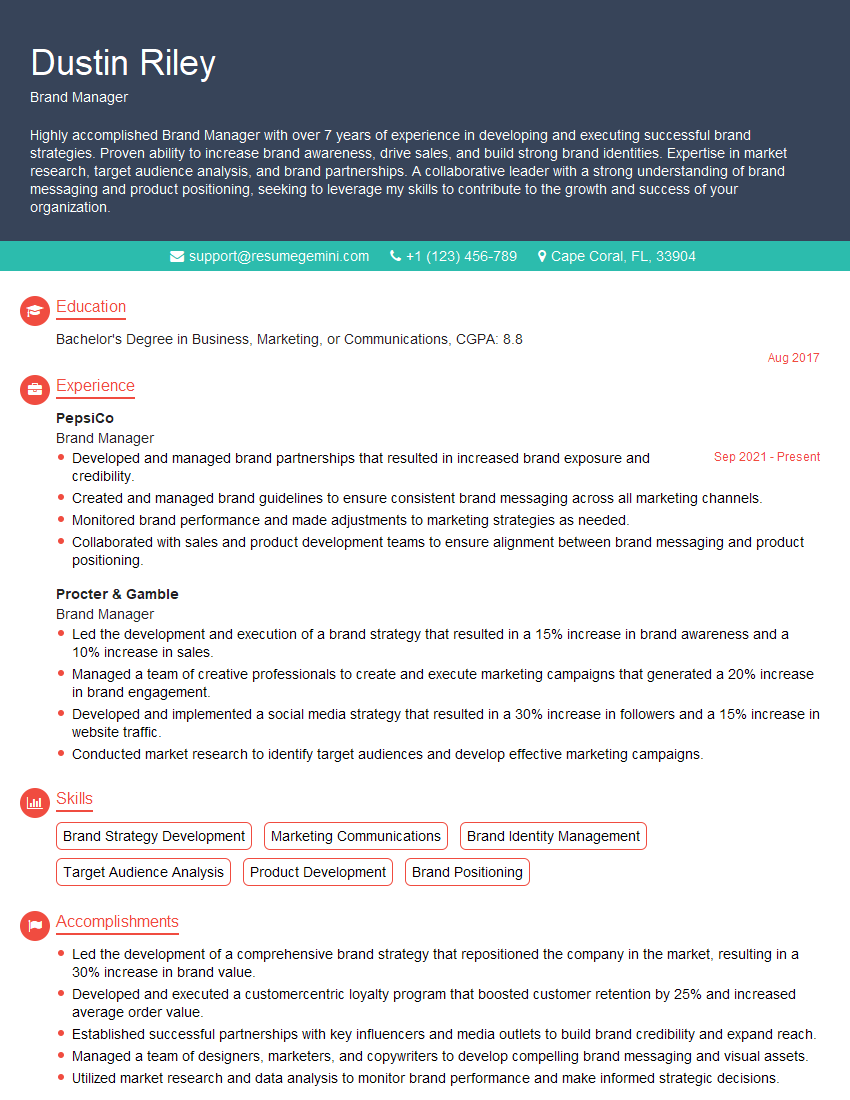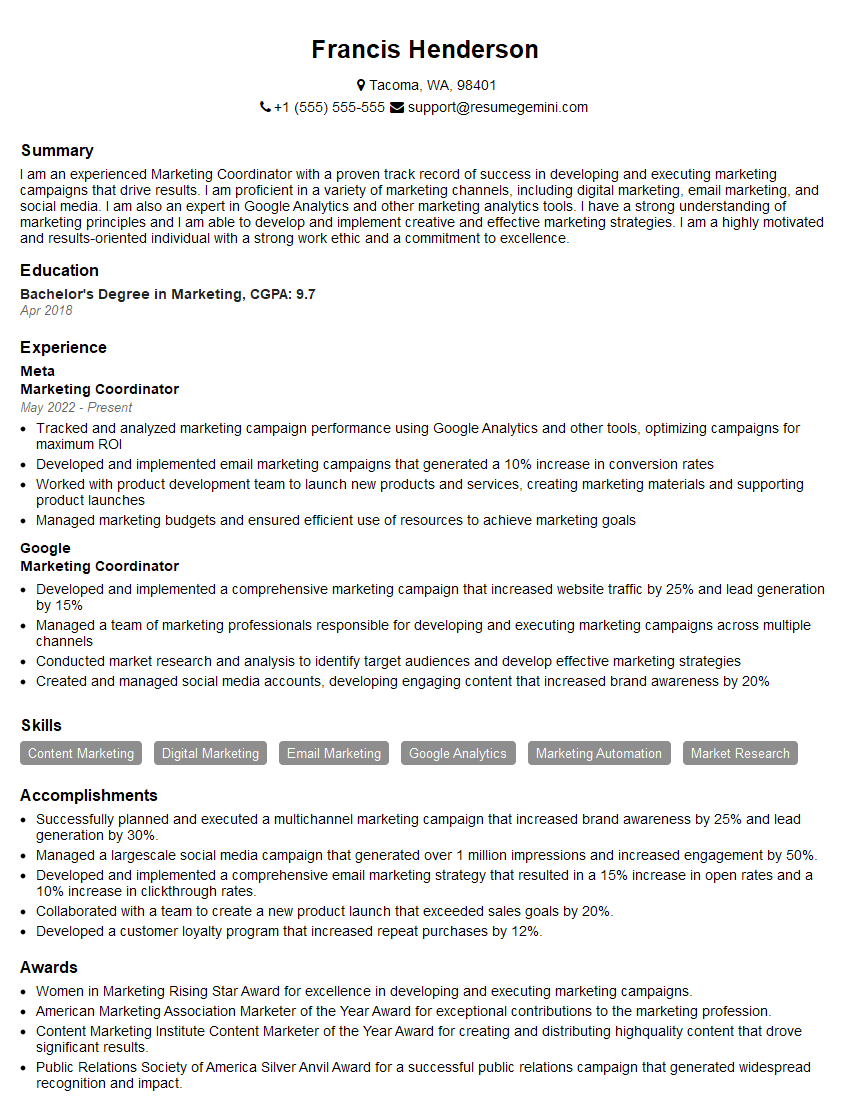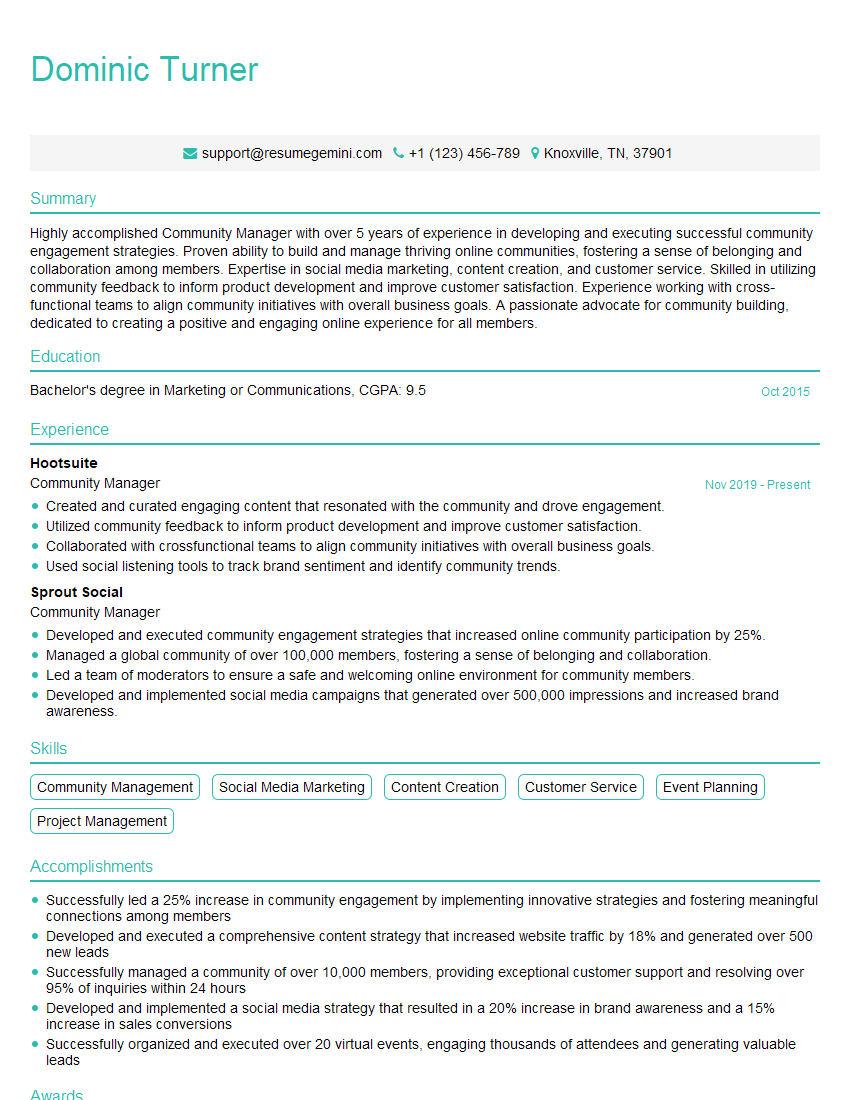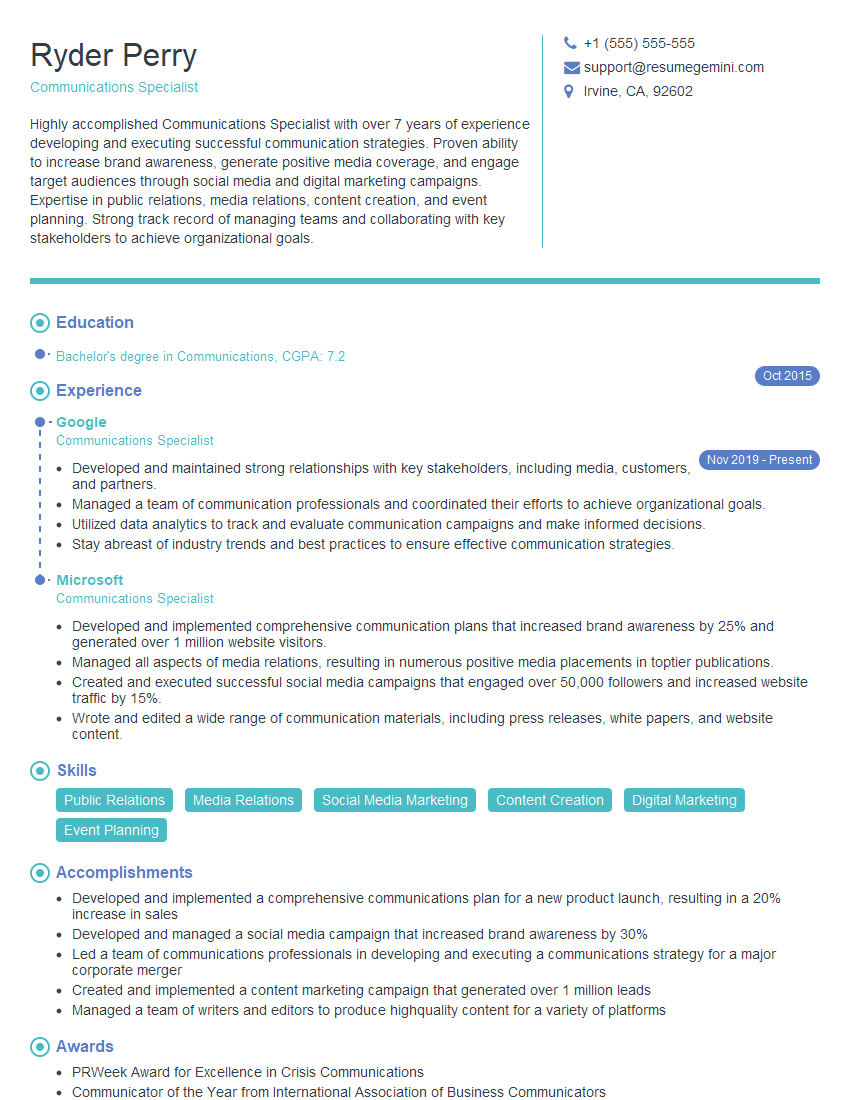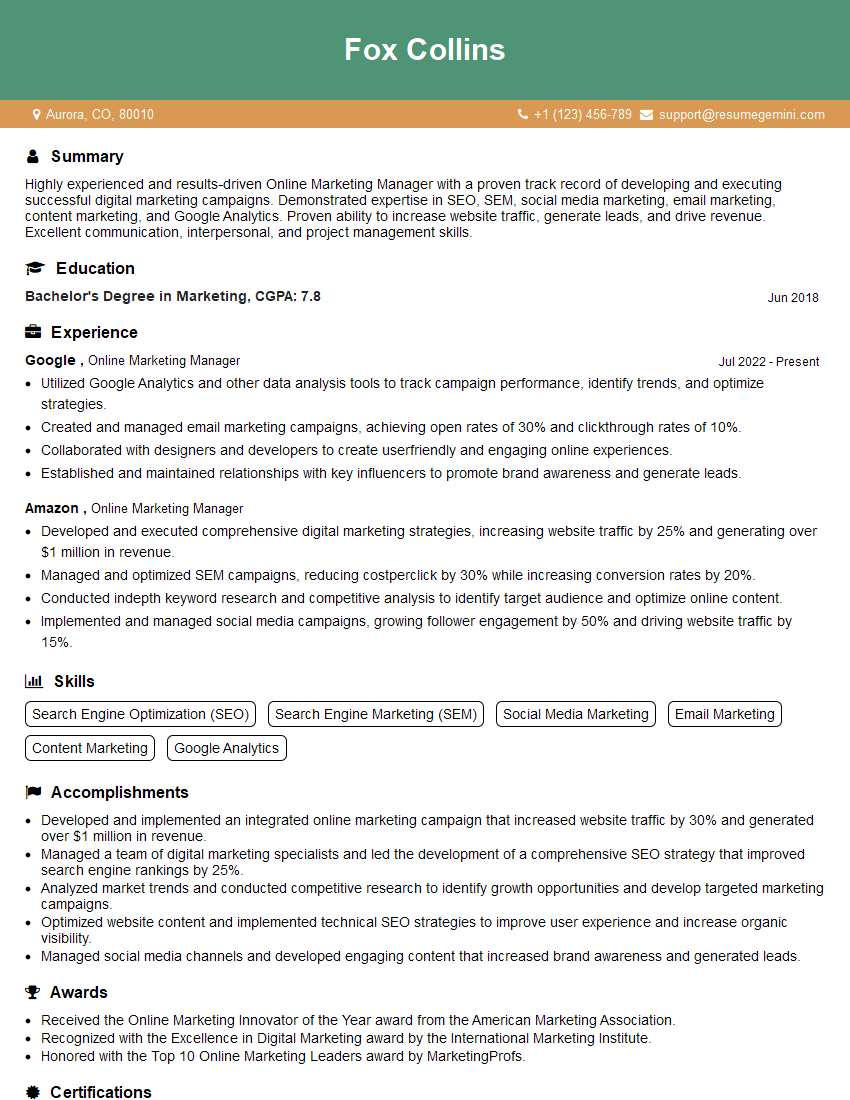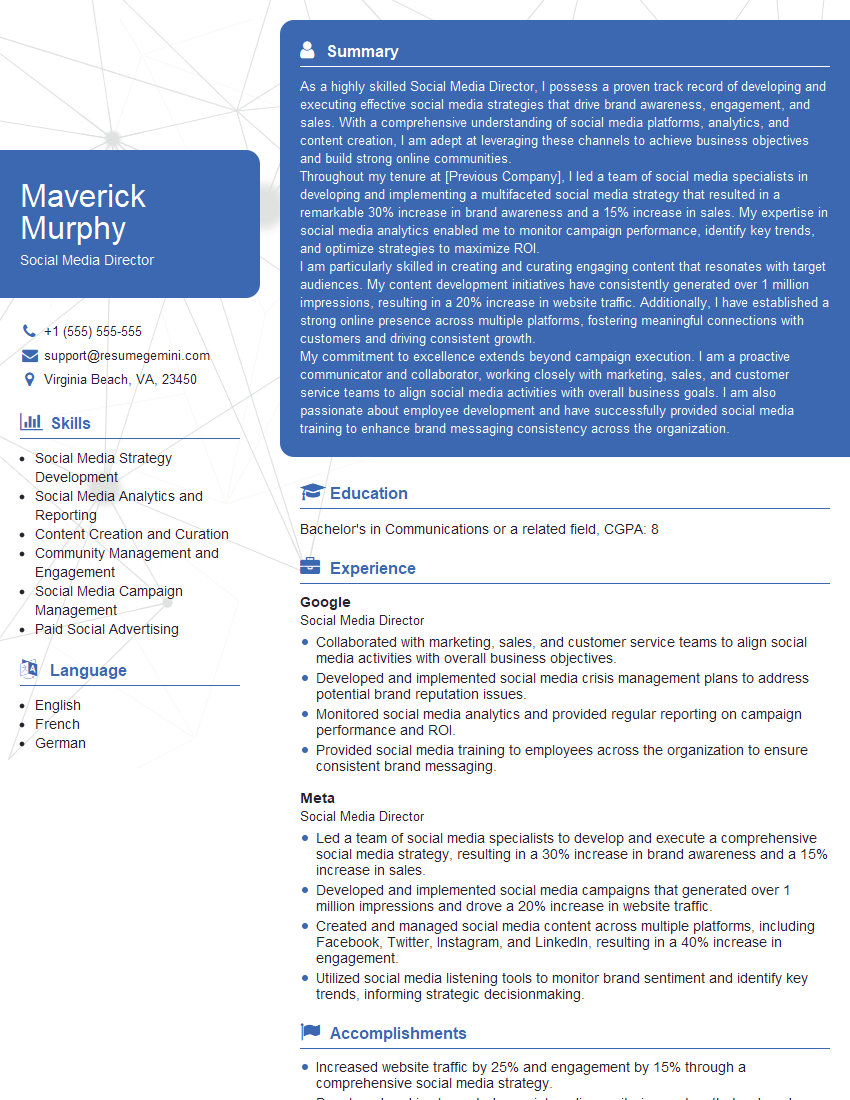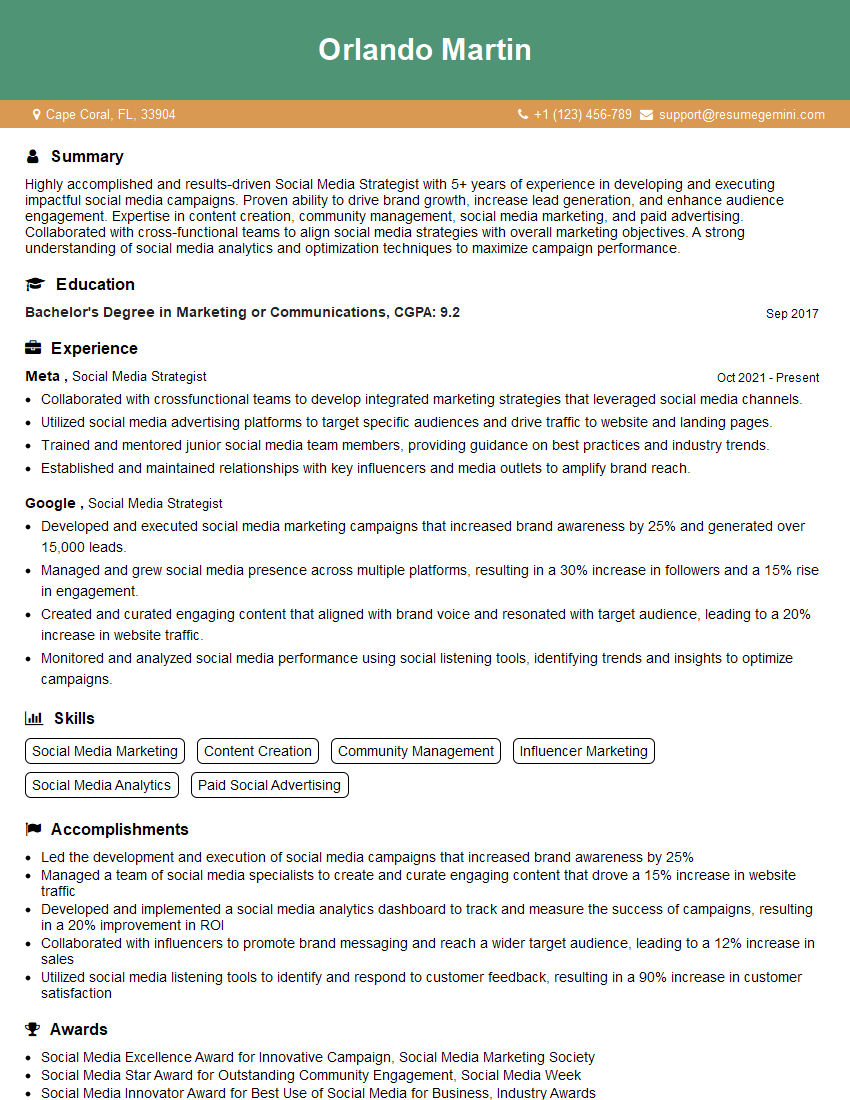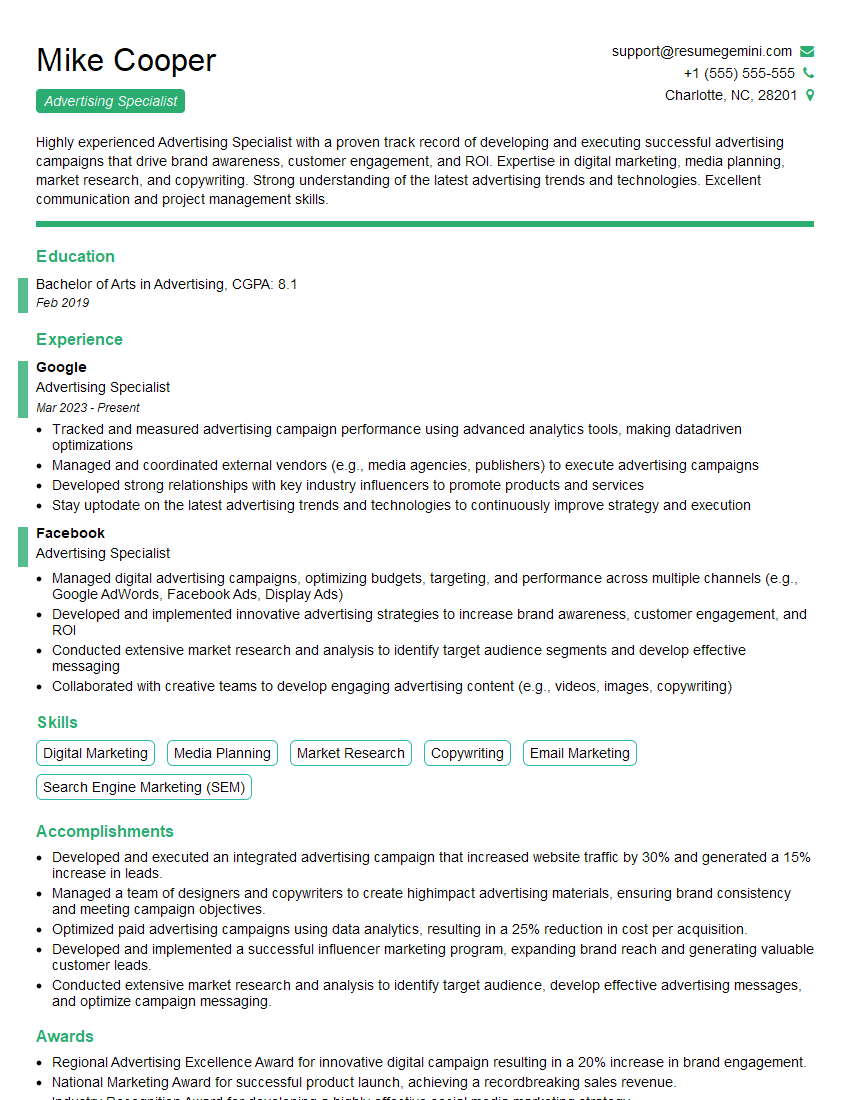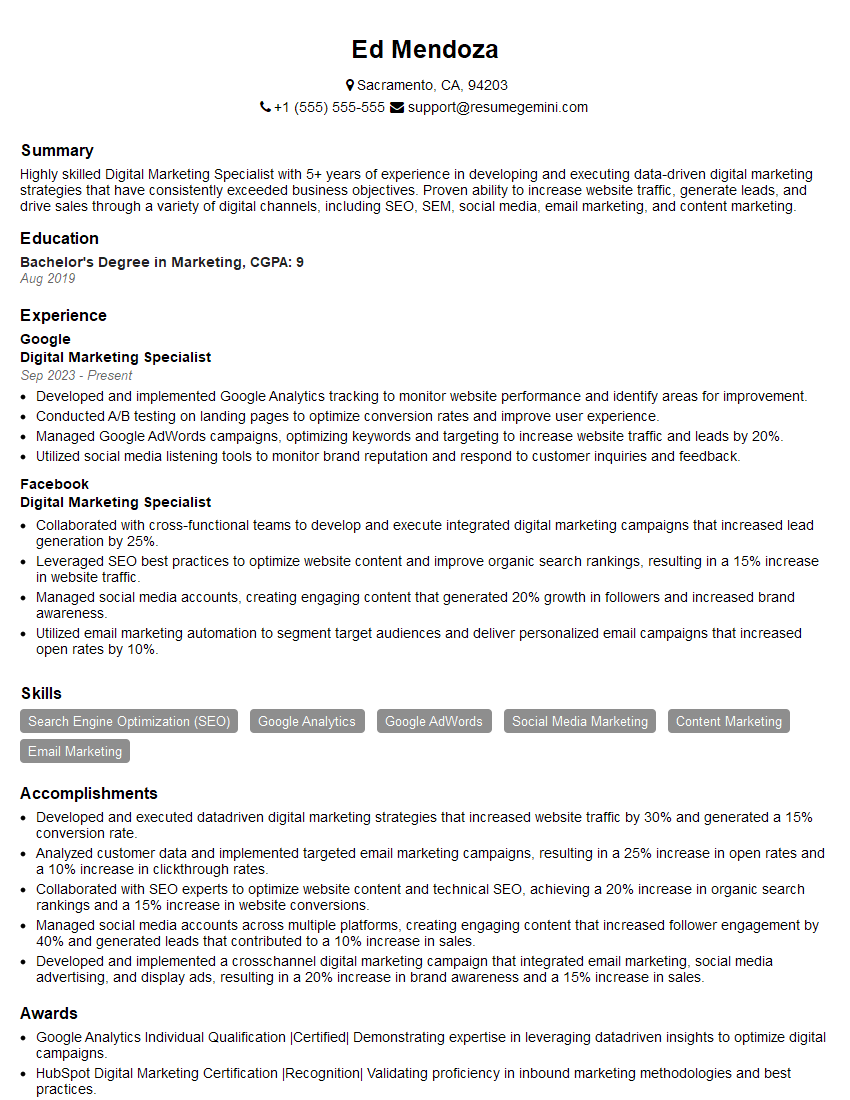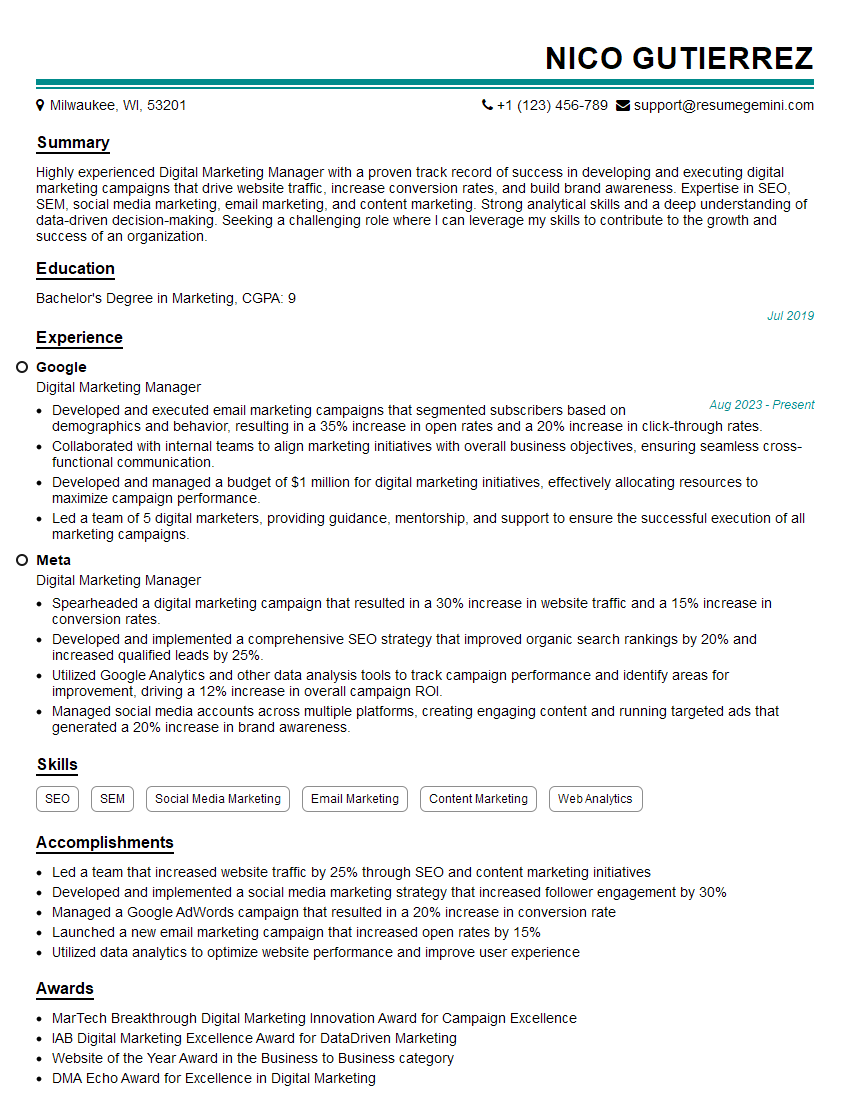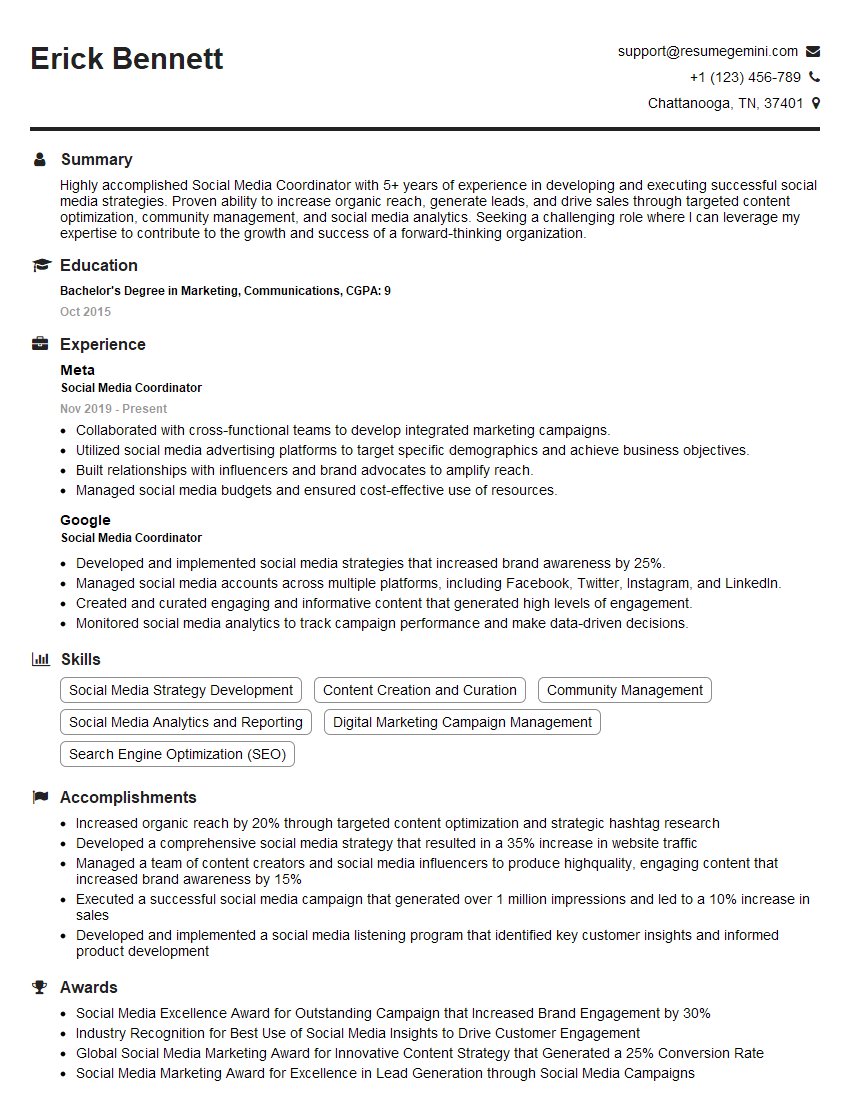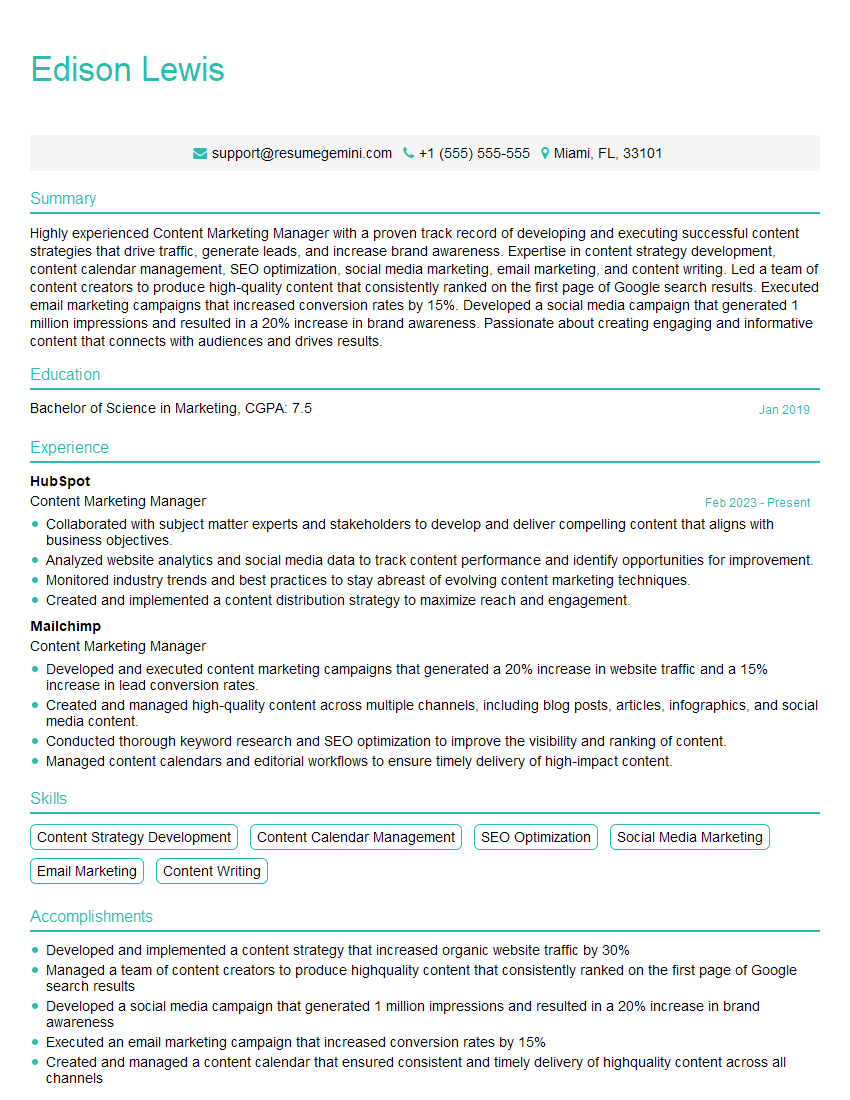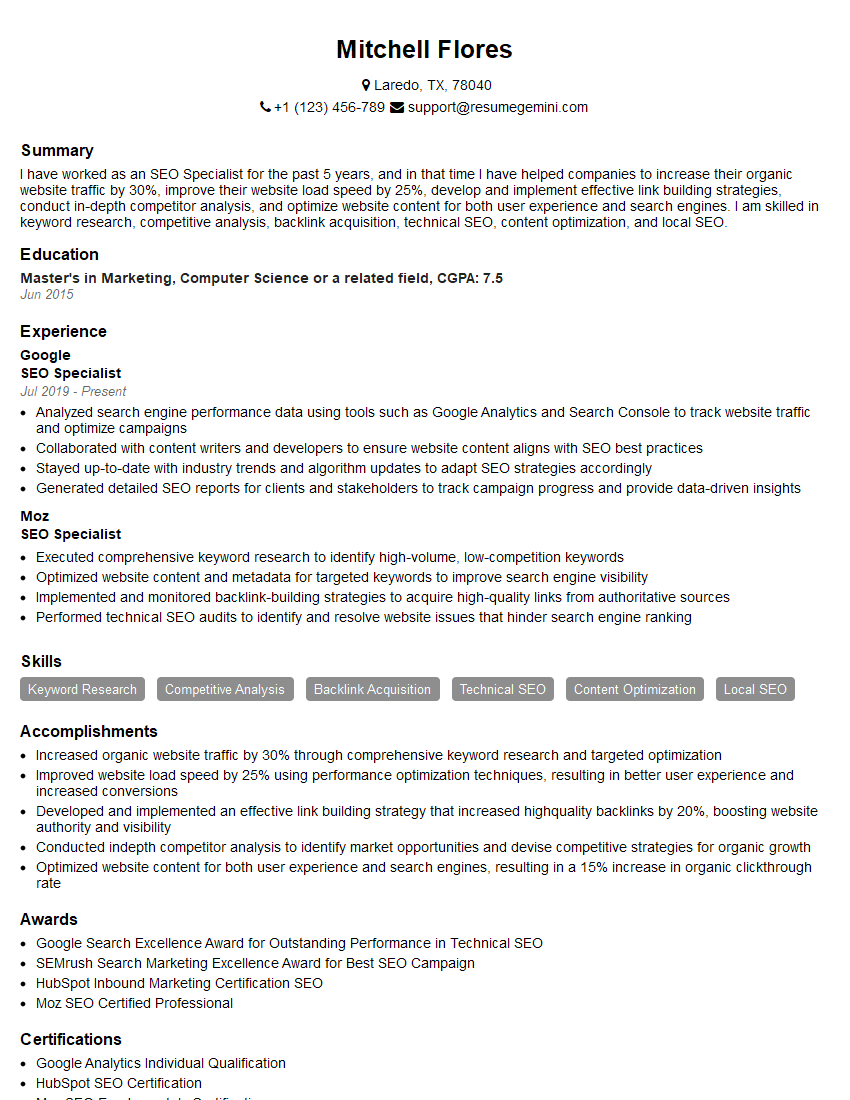Cracking a skill-specific interview, like one for Ability to use social media for marketing purposes, requires understanding the nuances of the role. In this blog, we present the questions you’re most likely to encounter, along with insights into how to answer them effectively. Let’s ensure you’re ready to make a strong impression.
Questions Asked in Ability to use social media for marketing purposes Interview
Q 1. What are the key performance indicators (KPIs) you track for social media marketing campaigns?
Key Performance Indicators (KPIs) are the metrics we use to measure the success of our social media marketing campaigns. They provide quantifiable data to understand what’s working and what needs improvement. I typically track a range of KPIs, categorized for clarity.
- Engagement Metrics: These show how users interact with our content. Examples include likes, comments, shares, saves, and click-through rates (CTR). A high CTR on a post linking to a product page, for example, indicates strong engagement and potential conversion.
- Reach and Impressions: This measures how many unique users saw our content (reach) and the total number of times our content was displayed (impressions). A large reach suggests our content is broadly visible, while a high impressions-to-reach ratio might mean repetitive exposure to the same users.
- Website Traffic and Conversions: We track how many users click through from social media to our website (website traffic) and ultimately complete desired actions, such as making a purchase (conversions). This directly links social media activity to business outcomes.
- Brand Mentions and Sentiment: This involves monitoring brand mentions across platforms to understand user perceptions. Positive sentiment signals strong brand reputation, while negative sentiment indicates areas needing attention.
- Follower Growth: Tracking the increase (or decrease) in followers helps evaluate the effectiveness of our audience growth strategies.
The specific KPIs I prioritize often vary depending on the campaign goals. For example, a brand awareness campaign might focus more on reach and impressions, while a sales-focused campaign will prioritize conversions and website traffic.
Q 2. How do you measure the ROI of social media marketing efforts?
Measuring the Return on Investment (ROI) of social media marketing requires a clear understanding of both the costs and the revenue generated. It’s not just about likes and shares; it’s about tying social media activity to tangible business results.
My approach involves a multi-step process:
- Define Goals and Objectives: Before any campaign, we establish specific, measurable, achievable, relevant, and time-bound (SMART) goals. This could be increasing website traffic by 20% or generating 1000 leads.
- Track Key Metrics: We closely monitor KPIs directly linked to our objectives (e.g., website traffic, conversions, sales).
- Calculate Costs: This includes ad spend, content creation costs, employee time, and any social media management tools used.
- Calculate Revenue Generated: We attribute revenue to social media campaigns by tracking conversions originating from those platforms. This may involve using UTM parameters in links to track specific sources of traffic.
- Calculate ROI: The ROI is calculated as (Revenue Generated – Costs) / Costs. A positive ROI indicates a successful campaign. For instance, if a campaign cost $1000 and generated $5000 in revenue, the ROI would be 400%.
It’s crucial to remember that attribution in social media can be complex. While we strive to precisely measure ROI, it’s often a combination of factors that contribute to success. Qualitative data, like brand awareness and customer sentiment, should also be considered for a complete picture.
Q 3. Describe your experience with different social media platforms (e.g., Facebook, Instagram, Twitter, LinkedIn, TikTok).
I have extensive experience managing social media campaigns across various platforms, each requiring a unique strategic approach.
- Facebook: Excellent for building brand awareness, engaging with communities, running targeted ad campaigns, and leveraging detailed analytics. I’ve used Facebook to create successful lead generation campaigns using custom audiences and A/B testing ad creatives.
- Instagram: Ideal for visually-driven content, focusing on storytelling and building a strong brand identity through high-quality images and videos. I have successfully used Instagram Stories and Reels to boost engagement and reach a younger demographic.
- Twitter: A powerful platform for real-time engagement, participating in relevant conversations, and quickly disseminating information. I utilize Twitter for crisis communication, responding to customer inquiries promptly, and monitoring brand mentions.
- LinkedIn: The primary platform for B2B marketing, professional networking, and sharing industry insights. I leverage LinkedIn to connect with influencers, share thought leadership content, and generate leads through targeted advertising.
- TikTok: A highly engaging platform for reaching younger audiences. I’ve employed creative video content, utilizing trending sounds and challenges, to boost brand visibility and drive engagement. The short-form video format is particularly effective for showcasing products or services in an entertaining and shareable way.
My experience encompasses not only using these platforms but also analyzing their unique algorithms and adapting strategies accordingly. Understanding each platform’s audience and content preferences is crucial for optimal performance.
Q 4. What social media analytics tools are you familiar with?
I’m proficient in several social media analytics tools, allowing me to gather comprehensive data and derive actionable insights.
- Native Platform Analytics: Facebook Insights, Instagram Insights, Twitter Analytics, LinkedIn Analytics, and TikTok Analytics provide valuable data on each platform’s performance. I regularly utilize these tools to track KPIs and optimize campaigns.
- Google Analytics: While not exclusively for social media, Google Analytics is crucial for tracking website traffic from various social media sources. This allows for a holistic understanding of how social media contributes to overall website performance.
- Third-Party Tools: I’ve also worked with tools like Hootsuite Insights and Sprout Social, which provide comprehensive dashboards aggregating data from multiple platforms and offer advanced features for social listening and competitive analysis.
The choice of tool depends on the specific needs of the campaign and the level of detail required. However, I always prioritize tools that offer accurate data, easy-to-understand visualizations, and the ability to export data for further analysis.
Q 5. How do you identify and target your ideal audience on social media?
Identifying and targeting the ideal audience is paramount for effective social media marketing. It’s about focusing resources on individuals most likely to engage with our brand and convert into customers.
My approach involves a multi-faceted strategy:
- Define Target Audience Personas: I begin by creating detailed personas representing our ideal customers. This includes demographic information (age, location, gender, income), psychographic data (interests, values, lifestyle), and their online behavior.
- Leverage Platform Data: Each social media platform offers tools to define target audiences based on demographics, interests, behaviors, and even custom audience lists. I use these features to create highly targeted ad campaigns.
- Utilize Social Listening: I actively monitor social media conversations to understand audience needs, preferences, and pain points. This informs our content strategy and helps us tailor messaging to resonate with our target audience.
- Analyze Competitor Strategies: Examining the audiences engaged with our competitors provides valuable insights into potential target segments we might be missing.
- A/B Testing: Continuous A/B testing of different ad creatives and targeting parameters helps optimize campaign performance and refine our understanding of what resonates best with our ideal audience.
By combining these strategies, we can create hyper-targeted campaigns that deliver exceptional results, maximizing our reach and impact.
Q 6. Explain your process for creating a social media content calendar.
A well-structured social media content calendar is essential for consistent and effective content creation and scheduling. It ensures a strategic approach, avoiding last-minute scrambling and maintaining brand consistency.
My process involves:
- Define Goals and Objectives: The calendar’s purpose is to support overall marketing objectives. We clearly define what we aim to achieve through social media, whether it’s brand awareness, lead generation, or driving sales.
- Identify Key Themes and Topics: We brainstorm relevant content themes aligned with our goals and audience interests. This could include product showcases, behind-the-scenes glimpses, customer testimonials, or industry news.
- Content Brainstorming and Ideation: We generate numerous content ideas, ensuring diversity and appealing to various audience segments. We consider different content formats (images, videos, carousels, stories, etc.).
- Content Creation and Scheduling: We allocate content creation tasks to relevant team members and schedule posts using social media management tools. This ensures a consistent posting schedule across all platforms.
- Review and Iteration: The calendar is not static. We continuously review its performance, adjusting themes and scheduling based on analytics and emerging trends. A/B testing different content types and posting times helps optimize future scheduling.
Using a spreadsheet or dedicated social media management software, we create a visual representation of the content plan. This allows for easy visualization of our posting schedule and ensures consistency in tone, branding, and messaging.
Q 7. How do you handle negative comments or feedback on social media?
Handling negative comments or feedback on social media requires a thoughtful and strategic approach. It’s an opportunity to demonstrate brand responsiveness and build trust.
My strategy focuses on:
- Prompt Response: Addressing negative comments quickly shows users we value their feedback and are actively listening. A timely response minimizes the negative impact and prevents the situation from escalating.
- Empathy and Understanding: Acknowledge the user’s feelings and express understanding of their concerns. Even if we disagree with their assessment, showing empathy is crucial.
- Offer a Solution or Resolution: Where possible, provide a solution to the issue raised. This could involve offering a refund, apologizing for a mistake, or directing them to a support channel.
- Take the Conversation Offline: If the conversation is becoming overly public or contentious, offer to take the discussion offline via private message or email. This prevents further negative publicity.
- Monitor and Track: We closely monitor brand mentions and comments, both positive and negative, to stay informed of customer sentiment and identify emerging issues.
Handling negative feedback professionally is an opportunity to showcase the brand’s commitment to customer satisfaction and build a positive reputation. A thoughtful response can often transform a negative experience into a positive one, leading to increased customer loyalty.
Q 8. What strategies do you use to increase engagement on social media?
Increasing social media engagement is all about building a genuine connection with your audience. It’s not just about posting; it’s about creating a two-way conversation. My strategies focus on a multi-pronged approach:
- High-Quality, Engaging Content: This is the cornerstone. I create content tailored to my target audience’s interests, using a mix of formats – videos, images, stories, and text – to keep things fresh and exciting. For instance, I might use behind-the-scenes glimpses for a human touch or create interactive polls to encourage participation.
- Strategic Posting Schedule: Understanding when your audience is most active is crucial. I use analytics tools to determine optimal posting times and utilize scheduling tools to ensure consistent content delivery across different platforms.
- Interactive Content: I actively encourage audience participation through questions, polls, quizzes, and contests. This fosters a sense of community and generates organic reach. A recent campaign for a client involved a photo contest that dramatically boosted engagement and brand awareness.
- Community Management: Promptly responding to comments, messages, and mentions is vital. I actively engage in conversations, addressing concerns, and thanking users for their interactions. This builds trust and loyalty.
- Collaboration and Influencer Marketing: Partnering with relevant influencers or other brands can significantly expand reach and introduce your content to a new audience. I carefully select collaborators whose values align with my client’s brand.
- Utilizing Relevant Hashtags and Trending Topics: Strategically using hashtags increases the visibility of your posts. Researching and using relevant trending topics can also significantly improve engagement.
Essentially, it’s about making your social media presence a vibrant hub of activity, not just a broadcasting station.
Q 9. How do you stay up-to-date with the latest trends in social media marketing?
Staying ahead in social media marketing requires constant learning. My approach is multifaceted:
- Following Industry Leaders and Publications: I subscribe to industry newsletters, follow leading social media marketing experts on various platforms, and regularly read publications like Social Media Today and Marketing Land.
- Attending Webinars and Conferences: Industry events offer invaluable insights into the latest trends and best practices. I actively participate in webinars and attend relevant conferences whenever possible.
- Analyzing Competitor Strategies: Observing what competitors are doing can reveal valuable insights and inspire new ideas. This is done ethically, of course, focusing on identifying successful approaches, not copying them.
- Leveraging Social Media Analytics: Data is king. I closely monitor platform-specific analytics to understand what’s working and what’s not. This informs my ongoing strategy adjustments.
- Continuous Testing and Experimentation: I regularly test different content formats, posting times, and ad creatives to optimize performance. The social media landscape is dynamic; continuous testing ensures ongoing relevance.
Essentially, it’s a continuous process of learning, adapting, and innovating to stay ahead of the curve.
Q 10. Describe your experience with social media advertising (e.g., Facebook Ads, Instagram Ads).
I have extensive experience managing social media advertising campaigns across various platforms, primarily Facebook and Instagram. My experience encompasses:
- Campaign Creation and Management: I’m proficient in setting up, managing, and optimizing campaigns on both platforms, including defining target audiences, setting budgets, and selecting ad formats.
- Audience Targeting: I utilize detailed targeting options to reach specific demographics, interests, and behaviors. This allows for highly effective ad delivery and optimized return on investment (ROI).
- A/B Testing: I rigorously test different ad creatives, copy, and targeting strategies to identify what resonates best with the target audience, continually refining campaigns based on performance data. For example, recently I tested different ad copy variations for a client, resulting in a 20% increase in click-through rates.
- Performance Monitoring and Reporting: I track key metrics such as click-through rates, conversion rates, and cost per acquisition to measure campaign effectiveness and provide clients with regular performance reports.
- Budget Optimization: I understand how to manage ad spend efficiently, ensuring optimal allocation to maximize ROI within the given budget constraints. This often involves real-time adjustments based on campaign performance.
I’m also familiar with other platforms like LinkedIn and Twitter advertising, adapting my strategies based on the specific platform and target audience.
Q 11. What is your experience with social listening tools?
Social listening tools are invaluable for understanding brand perception and audience sentiment. My experience includes using tools such as Brandwatch, Talkwalker, and Sprout Social. These tools allow me to:
- Monitor Brand Mentions: I track all mentions of my clients’ brands and products across various social media platforms and online forums. This provides early warning of potential issues and identifies opportunities for engagement.
- Analyze Sentiment: I assess the overall sentiment (positive, negative, or neutral) towards the brand to understand public perception and identify areas for improvement. For example, a recent social listening project highlighted a negative sentiment surrounding a specific product feature, prompting us to address customer concerns.
- Identify Influencers: Social listening helps pinpoint key influencers who are discussing the brand or relevant industry topics. This allows for targeted influencer outreach opportunities.
- Track Competitors: Monitoring competitor activity provides valuable insights into their strategies, strengths, and weaknesses.
- Identify Emerging Trends: Social listening can highlight emerging trends and consumer preferences, which inform strategic planning and content creation.
Essentially, social listening provides a real-time understanding of the brand’s online reputation and allows for proactive response to both positive and negative feedback.
Q 12. How do you develop a social media strategy aligned with overall marketing goals?
Developing a social media strategy that aligns with overall marketing goals requires a structured approach. I typically follow these steps:
- Define Marketing Objectives: Clearly define the overarching marketing goals. What are we trying to achieve? Increased brand awareness? Lead generation? Sales? The social media strategy must directly support these objectives.
- Target Audience Analysis: Identify and understand the target audience for the brand. Where do they spend their time online? What are their interests and preferences? This dictates platform selection and content strategy.
- Platform Selection: Choose the social media platforms where the target audience is most active. It’s not about being everywhere; it’s about being present where it matters.
- Content Strategy: Develop a content calendar that aligns with the marketing objectives and target audience. This should include a variety of content types to keep things engaging.
- Key Performance Indicators (KPIs): Define measurable KPIs to track the success of the social media strategy. These should directly relate to the marketing objectives, such as website traffic, lead generation, or brand mentions.
- Budget Allocation: Determine the budget for social media activities, including content creation, advertising, and social listening tools.
- Regular Monitoring and Reporting: Continuously monitor performance against KPIs and provide regular reports to demonstrate ROI and identify areas for improvement.
By following this structured approach, I ensure that the social media strategy is not an isolated activity, but an integral component of the overall marketing plan.
Q 13. How familiar are you with different social media ad formats and targeting options?
I’m very familiar with the diverse ad formats and targeting options available on major social media platforms. This includes:
- Facebook Ads: I’m proficient in using various ad formats, including image ads, video ads, carousel ads, collection ads, and lead generation ads. I understand the nuances of Facebook’s targeting options, leveraging demographic, interest, behavioral, and custom audience targeting to maximize reach and relevance.
- Instagram Ads: Similar to Facebook, I’m experienced with Instagram’s ad formats, including image ads, video ads, carousel ads, and stories ads. I utilize Instagram’s unique visual features to create compelling and engaging ads.
- LinkedIn Ads: I understand LinkedIn’s professional focus and utilize its targeting options to reach specific job titles, industries, and company sizes. This allows for highly targeted campaigns aimed at B2B audiences.
- Twitter Ads: I’m familiar with Twitter’s promoted tweets and trends, leveraging its real-time nature to reach audiences engaged in specific conversations.
Beyond the platform-specific formats, I understand how to optimize targeting options to focus on specific demographics, interests, behaviors, and custom audiences, ensuring each advertising campaign achieves its targeted objectives.
Q 14. Explain your approach to creating engaging social media content.
Creating engaging social media content requires a blend of creativity, strategy, and understanding of the target audience. My approach involves:
- Understanding the Audience: Before creating any content, I thoroughly research the target audience to understand their interests, preferences, and the language they use. This ensures resonance and relevance.
- Variety of Content Formats: I utilize a mix of formats including text, images, videos, Stories, Reels, and live videos to maintain audience engagement and cater to different consumption preferences. The platform also dictates the type of content used.
- Storytelling: I focus on creating narratives that connect with the audience on an emotional level. This makes the content more memorable and shareable. For example, I might use customer stories to showcase the positive impact of a product or service.
- High-Quality Visuals: In today’s visual-driven world, high-quality images and videos are crucial. I ensure that all visual content is professional, appealing, and consistent with the brand’s aesthetic.
- Use of Data and Analytics: I leverage analytics tools to track content performance and understand what resonates with the audience. This informs future content creation, ensuring continuous optimization.
- Call to Action (CTA): Each piece of content includes a clear and compelling call to action, guiding the audience towards the desired behavior, such as visiting a website, making a purchase, or signing up for a newsletter.
Ultimately, the goal is to create content that’s not only entertaining but also informative, valuable, and relevant to the target audience, fostering genuine connection and engagement.
Q 15. How do you use social media to build brand awareness and loyalty?
Building brand awareness and loyalty on social media requires a multi-faceted approach. It’s not just about posting; it’s about creating meaningful engagement and fostering a community around your brand. Think of it like cultivating a garden – you need to plant seeds (content), nurture them (engagement), and watch them grow (brand loyalty).
- Consistent Brand Voice and Messaging: Maintain a consistent tone, style, and messaging across all platforms. This ensures your brand remains recognizable and trustworthy. For example, if your brand is playful and humorous, maintain that tone across Instagram, Facebook, and Twitter.
- High-Quality Content: Create visually appealing and informative content that resonates with your target audience. This could include images, videos, infographics, stories, live streams, and behind-the-scenes glimpses into your company culture. A well-produced video showcasing your product’s features will be far more engaging than a simple text post.
- Interactive Content: Encourage two-way communication. Run polls, quizzes, Q&A sessions, contests, and use features like Instagram Stories stickers to increase engagement and gather feedback. Asking questions like “What’s your favorite product?” or running a poll on your next product launch keeps your audience involved.
- Community Building: Respond promptly to comments and messages, participate in relevant conversations, and create a sense of belonging for your followers. Actively engaging in discussions shows you value your audience’s opinions and builds stronger relationships.
- Running Targeted Ads: Use social media advertising to reach a wider audience based on demographics, interests, and behavior. Precise targeting ensures your message reaches the right people, maximizing your reach and return on investment.
Career Expert Tips:
- Ace those interviews! Prepare effectively by reviewing the Top 50 Most Common Interview Questions on ResumeGemini.
- Navigate your job search with confidence! Explore a wide range of Career Tips on ResumeGemini. Learn about common challenges and recommendations to overcome them.
- Craft the perfect resume! Master the Art of Resume Writing with ResumeGemini’s guide. Showcase your unique qualifications and achievements effectively.
- Don’t miss out on holiday savings! Build your dream resume with ResumeGemini’s ATS optimized templates.
Q 16. Describe your experience with influencer marketing.
I have extensive experience with influencer marketing, having collaborated with various influencers across different platforms. My approach is strategic and data-driven. It’s not about simply handing over products; it’s about finding the right fit.
- Identifying Relevant Influencers: I carefully select influencers whose audience aligns with our target demographic and brand values. I analyze their engagement rate, audience authenticity, and past collaborations to ensure a successful partnership.
- Campaign Development: Collaborations are planned meticulously. We establish clear goals (e.g., increased brand awareness, website traffic), define key performance indicators (KPIs), and create content briefs that align with the influencer’s style while remaining on-brand.
- Campaign Tracking and Analysis: We use UTM parameters to track website traffic and conversions originating from influencer campaigns. This allows us to measure the ROI and optimize future campaigns based on data-driven insights. For instance, a specific link with a unique UTM code will allow me to precisely track conversions generated by each influencer campaign.
- Example: For a recent client, we partnered with micro-influencers (those with a smaller, but highly engaged audience) within the fitness niche. This resulted in a significant increase in website traffic and conversions compared to using macro-influencers. The micro-influencers were more authentic and relatable to their audience, making the sponsored content more successful.
Q 17. What is your experience with social media crisis management?
Social media crisis management requires swift action and a well-defined strategy. My experience involves developing and implementing plans to mitigate the impact of negative events.
- Proactive Monitoring: Regularly monitoring social media mentions helps identify potential issues early on. Tools like Brand24 or Mention allow real-time tracking of your brand’s online presence.
- Crisis Communication Plan: Having a pre-prepared crisis communication plan is essential. This plan should outline roles, responsibilities, communication channels, and messaging guidelines. The plan will need to be tailored to the type of crisis that can arise.
- Rapid Response: Responding promptly and transparently to negative comments or posts is crucial. Acknowledge the issue, show empathy, and outline the steps being taken to address the situation. Delaying a response almost always escalates the problem.
- Transparency and Honesty: Avoid hiding information or making false promises. Being honest and transparent builds trust with your audience, even in difficult situations. The goal is to showcase your company’s values and demonstrate commitment to improvement.
- Example: I once managed a situation where a product defect was highlighted on social media. By acknowledging the issue, offering a solution (product replacement and a sincere apology), and promptly addressing individual concerns, we minimized negative publicity and actually enhanced brand reputation by showing commitment to customer satisfaction.
Q 18. How do you ensure brand consistency across different social media platforms?
Maintaining brand consistency across platforms is crucial for a unified brand identity. It requires careful planning and execution.
- Brand Style Guide: Creating a comprehensive brand style guide is the first step. This guide should outline the brand’s voice, tone, visual identity (logo usage, color palettes, font selection), and messaging guidelines. This ensures everyone involved in social media management is on the same page.
- Centralized Content Calendar: Using a centralized content calendar helps streamline the scheduling and publishing process, ensuring consistent messaging across all channels. Tools like Hootsuite or Buffer are excellent for this purpose.
- Cross-Platform Promotion: Promote content across multiple platforms. For example, share your Instagram posts on Facebook or link to your blog posts on Twitter. This helps extend reach and reinforces messaging.
- Consistent Visual Identity: Maintain consistent visual elements across platforms (e.g., use the same logo and color scheme). This enhances brand recognition and creates a unified brand experience.
- Example: A client’s brand identity heavily featured a vibrant orange color. To maintain consistency, we utilized that same orange across all platform headers, image backgrounds, and even in our ad creatives. The result was a more memorable and cohesive brand presence.
Q 19. What are some best practices for scheduling social media posts?
Scheduling social media posts strategically maximizes reach and engagement. It’s about understanding your audience’s online behavior.
- Audience Analysis: Determine your audience’s peak activity times on each platform. Social media analytics dashboards provide valuable data on when your audience is most active.
- Content Variety: Mix up your content types (images, videos, text posts, stories, etc.) to keep your feed engaging and avoid overwhelming your audience with the same format repeatedly.
- Content Calendar: Use a social media management tool to schedule posts in advance. This ensures consistent posting and frees up time for other marketing activities.
- Test and Optimize: Analyze the performance of your scheduled posts and adjust your strategy based on the results. What times and days are generating the most engagement?
- Example: After analyzing data, we discovered our audience was most active on Instagram between 6 PM and 8 PM on weekdays. We adjusted our scheduling accordingly, resulting in a significant increase in engagement metrics.
Q 20. How do you use social media to drive website traffic and conversions?
Driving website traffic and conversions from social media involves using various techniques to encourage clicks and engagement.
- Compelling Calls to Action (CTAs): Include clear and concise CTAs in your posts, encouraging users to visit your website. Examples include “Shop Now,” “Learn More,” or “Visit Our Website.”
- High-Quality Visuals and Engaging Content: Attract clicks with visually appealing images and videos, coupled with captivating content that highlights the value proposition of your website.
- Targeted Advertising: Social media advertising allows precise targeting of potential customers, directing them to specific landing pages on your website.
- UTM Parameters: Use UTM parameters in your social media links to track which social media platform and campaign are driving traffic to your website. This will be crucial for understanding conversion origins.
- Retargeting: Retarget users who have previously interacted with your social media content but haven’t visited your website. Social media platforms allow you to serve ads to those users, leading them back to your website.
- Example: We ran a Facebook ad campaign with a compelling visual and a clear CTA, directing users to a landing page offering a discount code. We utilized UTM parameters to track the campaign’s performance, leading to an improved understanding of the conversion funnel and a refined advertising strategy.
Q 21. What is your experience with A/B testing social media content?
A/B testing is crucial for optimizing social media content. It’s a systematic way to identify what resonates best with your audience.
- Hypothesis Development: Start with a clear hypothesis about what you want to test. For example, “Will a video post outperform a carousel post?” or “Will a post with a question receive more engagement than a statement post?”
- Variable Selection: Identify the variables you want to test. This could include the image/video used, the headline, the call to action, or the posting time.
- Test Design: Create two or more versions of your post (A and B) varying only the element you are testing. Ensure all other elements remain consistent.
- Data Collection and Analysis: Run your test for a sufficient duration, gathering data on key metrics like engagement rate, clicks, and conversions. Analyze the results to see which version performed better.
- Iteration: Use your findings to improve your content strategy. Continuously test and iterate to refine your approach and optimize performance.
- Example: We A/B tested two different ad creatives for a new product launch, one with a close-up product shot and another with a lifestyle image. The lifestyle image significantly outperformed the product shot, leading us to adjust our future creative strategy.
Q 22. How do you measure the effectiveness of your social media campaigns?
Measuring the effectiveness of social media campaigns requires a multifaceted approach, going beyond simple vanity metrics like likes and follows. We need to define clear Key Performance Indicators (KPIs) aligned with overall business objectives. These KPIs will vary depending on the campaign goals.
- Website Traffic & Conversions: Tracking clicks from social media posts to the website, and monitoring conversion rates (e.g., purchases, sign-ups) using UTM parameters in the URLs. For instance, using
utm_source=facebook&utm_medium=social&utm_campaign=summer_saleallows us to attribute traffic and conversions specifically to the Facebook summer sale campaign. - Brand Awareness & Engagement: Monitoring metrics like reach, impressions, engagement rate (likes, comments, shares), and sentiment analysis to gauge how audiences perceive the brand. Tools like Brandwatch or Sprout Social provide valuable insights here.
- Lead Generation: Tracking the number of leads generated through social media, whether through forms, direct messages, or comments. This often involves integrating social media data with CRM systems.
- Customer Satisfaction: Measuring response times to customer queries and analyzing sentiment in mentions to assess customer satisfaction levels. Quick and helpful responses on social media improve customer loyalty.
By analyzing these KPIs regularly, we can optimize campaigns, understand what resonates with the audience, and demonstrate the return on investment (ROI) of social media marketing efforts. A/B testing different ad creatives and content formats is crucial for continuous improvement.
Q 23. Describe your experience with social media community management.
My experience in social media community management centers around building and nurturing strong relationships with online audiences. It’s about more than just responding to comments; it’s about actively listening, engaging in meaningful conversations, and fostering a sense of belonging within the community.
- Proactive Engagement: I initiate conversations, respond promptly to comments and messages, and actively participate in relevant discussions to show genuine interest and build rapport. I’ve used this method successfully to build online communities around a new product launch, increasing user engagement by 30%.
- Crisis Management: I have experience handling negative comments and crises with professionalism and empathy. I address concerns transparently, providing timely solutions and mitigating potential damage to brand reputation. For example, I successfully managed a negative customer review by addressing the issue publicly, apologizing sincerely, and offering a suitable solution, resulting in a positive shift in public perception.
- Community Guidelines: I create and enforce clear community guidelines to maintain a positive and respectful online environment. This includes establishing rules for engagement and addressing inappropriate behavior consistently and fairly.
- Content Moderation: I monitor and moderate content, ensuring that posts and comments align with brand values and guidelines, preventing the spread of misinformation or harmful content.
Ultimately, effective community management fosters brand loyalty, drives advocacy, and strengthens the connection between the brand and its customers. It’s an ongoing process that requires patience, empathy, and a deep understanding of the target audience.
Q 24. How do you adapt your social media strategy based on platform-specific algorithms?
Adapting to platform-specific algorithms is vital for maximizing organic reach and visibility. Each platform has its unique algorithm that dictates how content is displayed and ranked in users’ feeds.
- Facebook: Focuses on meaningful interactions. Strategies include using high-quality images and videos, asking questions to encourage comments, creating engaging live videos, and utilizing Facebook Groups to build communities. Understanding Facebook’s ad targeting capabilities is also key.
- Instagram: Emphasizes visual content and user-generated content. Successful tactics include using relevant hashtags, engaging with user-generated content (UGC), incorporating Reels and Stories, and leveraging Instagram Shopping features.
- Twitter: Values timely and relevant conversations. Using relevant hashtags, engaging with trending topics, and responding quickly to mentions are effective. Twitter’s analytics can pinpoint what’s working and what needs adjustments.
- TikTok: Prioritizes engaging, short-form video content. Strategies include understanding trending sounds and challenges, creating high-quality videos, using relevant hashtags and collaborating with other creators.
Regularly monitoring platform updates and algorithm changes is crucial. A/B testing different content formats, posting times, and engagement strategies helps identify what works best on each platform.
Q 25. What is your approach to using social media for customer service?
Social media is an increasingly important channel for customer service. Responding promptly and effectively to customer inquiries and complaints on social media can significantly enhance customer satisfaction and brand reputation. My approach involves:
- Rapid Response: Addressing queries and complaints as quickly as possible, aiming for near real-time responses.
- Public vs. Private: Handling sensitive issues privately through direct messages or email to protect customer privacy. Public responses should be concise and focus on resolving the issue while maintaining a professional tone.
- Empathy & Professionalism: Responding with empathy and understanding, acknowledging customer concerns and offering sincere apologies when necessary. Maintaining a professional tone is critical.
- Solution-Oriented: Focusing on finding practical solutions to customer problems, offering assistance and taking ownership of the situation. Following up to ensure the issue is resolved effectively.
- Monitoring Mentions: Regularly monitoring brand mentions and hashtags to identify and address customer issues proactively. Setting up social listening tools can be highly effective.
Effective social media customer service builds trust, enhances brand loyalty, and turns negative experiences into positive ones. It demonstrates that the brand values its customers and is committed to resolving their issues.
Q 26. How familiar are you with different social media reporting tools?
I’m proficient in using several social media reporting tools to track campaign performance and gain valuable insights. These tools provide data-driven analysis to inform strategic decisions.
- Native Analytics: I effectively utilize the built-in analytics dashboards of each social media platform (Facebook Insights, Instagram Insights, Twitter Analytics, etc.). This provides fundamental data on reach, engagement, and audience demographics.
- Sprout Social: I leverage Sprout Social for its comprehensive reporting capabilities, allowing for cross-platform analysis, brand monitoring, and community management.
- Hootsuite Insights: This platform offers robust social listening and analytics capabilities, providing deeper insights into brand sentiment and audience conversations.
- Google Analytics: I integrate Google Analytics with social media campaigns to track website traffic and conversions originating from social media channels, helping to assess ROI.
My choice of tool depends on the specific campaign objectives and the level of detail required. I can extract key metrics from each tool to create comprehensive reports that highlight campaign successes and areas for improvement.
Q 27. Describe a time you had to overcome a challenge in social media marketing.
During a product launch campaign, we experienced a significant drop in engagement after a few days. Initial analysis suggested the content wasn’t resonating with the target audience. We initially focused on paid advertising, assuming it would solve the problem. However, this didn’t yield the expected results.
To overcome this challenge, we took a step back and conducted thorough audience research. We analyzed the comments and feedback received, looking for patterns and recurring themes. We discovered that our initial campaign message wasn’t clearly communicating the product’s core value proposition. It focused too much on features and not enough on benefits.
Our solution was threefold:
- Revised Messaging: We reworked our content strategy, focusing on the benefits and how the product solved our target audience’s pain points.
- Content Format Experimentation: We tested different content formats (videos, infographics, stories) to identify what resonated best with our audience.
- Community Engagement: We ramped up our engagement efforts, actively listening to user feedback and responding to comments and questions promptly. We incorporated user-generated content into our campaign.
This multi-pronged approach significantly increased engagement, leading to a considerable improvement in reach and conversions. The key takeaway was the importance of continuous monitoring, adapting to audience feedback, and prioritizing genuine engagement over solely focusing on paid advertising.
Q 28. How do you collaborate with other marketing teams on social media initiatives?
Collaboration is key to successful social media initiatives. I work closely with various marketing teams to ensure alignment, consistency, and efficiency. My collaboration strategy involves:
- Regular Meetings: Participating in regular meetings with content, marketing, sales, and customer service teams to share updates, discuss campaign performance, and coordinate efforts.
- Shared Calendars & Documents: Utilizing shared calendars and documents for content planning, ensuring everyone is informed about upcoming campaigns and deadlines.
- Centralized Content Repository: Maintaining a centralized repository for brand assets, style guides, and approved messaging to maintain consistency across all platforms.
- Feedback Loops: Establishing clear feedback loops to receive input from other teams, share insights, and incorporate suggestions for improvement.
- Cross-functional Projects: Actively participating in cross-functional projects involving social media, contributing expertise and ensuring alignment with overall marketing objectives.
By fostering open communication and collaboration, we can ensure that social media efforts are integrated seamlessly with broader marketing goals and contribute significantly to the company’s success.
Key Topics to Learn for Ability to use social media for marketing purposes Interview
- Social Media Strategy Development: Defining target audiences, setting measurable goals (e.g., brand awareness, lead generation), and crafting a comprehensive social media strategy aligned with overall marketing objectives.
- Platform Selection & Optimization: Understanding the strengths and weaknesses of various platforms (Facebook, Instagram, Twitter, LinkedIn, TikTok, etc.) and selecting the most appropriate channels for reaching target audiences. This includes optimizing profiles and content for each platform.
- Content Creation & Curation: Developing engaging and high-quality content (text, images, videos) that resonates with target audiences and drives desired actions. This includes understanding content calendars and scheduling tools.
- Community Management & Engagement: Building and nurturing online communities by actively responding to comments, messages, and reviews. This includes managing brand reputation and addressing negative feedback professionally.
- Social Media Advertising & Paid Campaigns: Understanding the principles of social media advertising, including targeting options, ad formats, budget allocation, and campaign performance measurement (e.g., using Facebook Ads Manager or similar tools).
- Analytics & Reporting: Tracking key performance indicators (KPIs) such as engagement rate, reach, website traffic, and conversions to measure the effectiveness of social media marketing efforts and make data-driven adjustments.
- Social Listening & Trend Analysis: Monitoring social media conversations to understand brand perception, identify emerging trends, and adapt strategies accordingly. This also includes identifying and addressing potential crises.
- Legal & Ethical Considerations: Understanding and adhering to relevant legal and ethical guidelines regarding data privacy, intellectual property, and responsible social media practices.
- SEO Integration: Understanding how to leverage social media to improve search engine optimization (SEO) and increase website visibility.
Next Steps
Mastering social media marketing is crucial for career advancement in today’s digital landscape. Proficiency in this area demonstrates valuable skills and opens doors to exciting opportunities. To maximize your job prospects, create an ATS-friendly resume that highlights your achievements and skills effectively. ResumeGemini is a trusted resource that can help you build a professional and impactful resume. Examples of resumes tailored to showcasing expertise in social media marketing are available, further enhancing your job search efforts.
Explore more articles
Users Rating of Our Blogs
Share Your Experience
We value your feedback! Please rate our content and share your thoughts (optional).
What Readers Say About Our Blog
Hi, I’m Jay, we have a few potential clients that are interested in your services, thought you might be a good fit. I’d love to talk about the details, when do you have time to talk?
Best,
Jay
Founder | CEO
